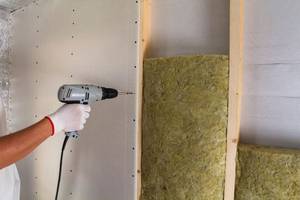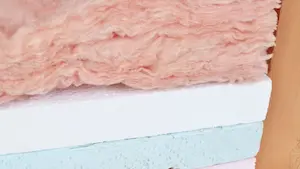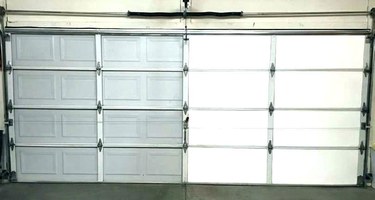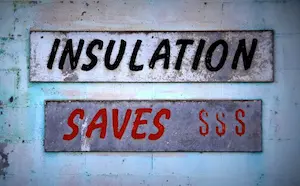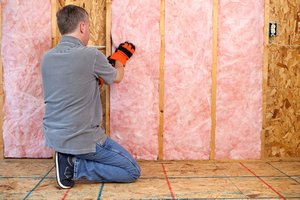Stay Warm in Winter and Cool in Summer with Insulated Garage Ceiling
This post contains affiliate links.
Insulation is crucial for a living area’s heating and cooling systems to work well. A lack of insulation will reduce the effectiveness of heating and cooling in a garage. Frequently, insulating the walls and garage door is not sufficient. As a result, it is also advised to insulate your garage ceiling.
To insulate your garage ceiling, you must first prepare the garage by making space and cleaning it. Afterward, you must measure the type of ceiling. Once that is done, choose the type of insulation material and install it by choosing the appropriate method.
Insulating the ceiling in your garage has several advantages, and you’ll get more if you do it yourself. We’ll guide you through the steps of insulating your garage ceiling in this post.
Pros and Cons of Insulating Garage Ceiling
There are a few pros and cons to insulating a garage ceiling. Some of them are discussed in this section.
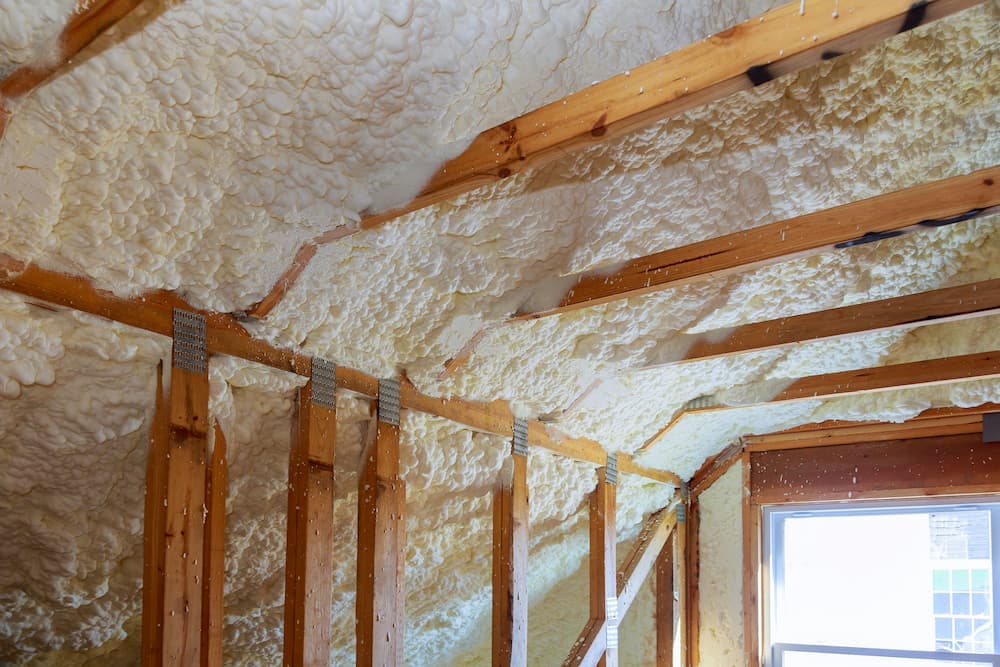
Pros of Insulating Garage Ceiling
Insulating a garage ceiling can provide several benefits for homeowners.
Energy Efficiency
One of the main benefits is energy efficiency. Insulating the garage ceiling reduces heat loss in the winter and heat gain in the summer, which can help lower heating and cooling costs.
This can be especially beneficial for those who use their garage as a living space or workspace, as they will be able to maintain a more comfortable temperature inside the garage.
Reduces Noise Pollution
Another benefit of insulating a garage ceiling is that it can help reduce noise pollution. Insulation helps to absorb and dampen sound, making it an excellent option for those who live near a busy street or have a loud family member who spends a lot of time in the garage.
Increases Value
Insulating a garage ceiling can also help improve a home’s overall value. A well-insulated garage can make a home more attractive to potential buyers, as it demonstrates that the homeowner has made an effort to improve the energy efficiency of their home.
Additionally, it can also make the garage more comfortable to use, increasing the overall enjoyment of the space.
Protection
Insulation also helps to protect your garage and its contents from extreme temperatures and humidity. This can be especially helpful for people who store valuable items, such as tools or equipment, in their garages.
Prevent Mold
Furthermore, insulating the garage ceiling can also help prevent condensation and mold growth. This is because insulation helps keep the temperature inside the garage more consistent, preventing moisture from building up and causing mold growth.
Cons of Insulating Garage Ceiling
Insulating a garage ceiling can provide many benefits for homeowners, but there are also some potential disadvantages to consider.
Mold
Another disadvantage is the potential for moisture and mold problems. If the insulation is not installed correctly or if there are any leaks in the garage, moisture can become trapped inside the insulation, leading to mold growth.
This can be a health hazard and can also cause damage to the insulation and the structure of the garage.
Read here why your garage may smell unusual.
Humidity
Additionally, if the garage is not properly ventilated, an insulated ceiling can trap excess heat and humidity in the summer. This can make the garage uncomfortable to use and can also cause damage to any items stored in the garage.
Inaccessibility
Another potential disadvantage is the difficulty of accessing the garage ceiling. Insulating the ceiling of a garage can be difficult and time-consuming, especially if the garage is attached to the house or if there are any obstacles in the way.
This can make it difficult to access and maintain the insulation, which can be a problem if any repairs or replacements are needed.
Suitability
Furthermore, not all garages are suitable for insulation. If your garage is not properly sealed or insulated. If you have a lot of air leaks, insulating the ceiling may not make sense, as the energy savings will be minimal. It’s always best to address any air leaks and consider insulation.
Additional Requirements
Finally, if you are planning to use the garage as a living space, additional steps such as finishing the walls, installing flooring, and providing proper ventilation must be taken to make it comfortable and safe. Insulating the ceiling alone will not be enough.
How to Insulate Garage Ceiling
Insulating a garage ceiling can be a relatively simple process if you have the suitable materials and tools. We’ve created a step-by-step guide on how to insulate a garage ceiling in this section.
Step 1: Prepare the Garage
Remove any items from the garage that may be in the way, such as storage boxes or furniture. You will also want to clean the garage ceiling to ensure it is free of dust and debris before you begin insulating.
Step 2: Measure the Garage Ceiling
Measure the length and width of the garage ceiling to determine the amount of insulation you will need. It is always best to have a little extra insulation on hand in case of any mistakes or oversights.
Step 3: Choose the Right Type of Insulation
There are several different types of insulation that can be used for a garage ceiling, including fiberglass batts, spray foam insulation, and blown-in cellulose. Each type has its own unique advantages and disadvantages, so it is important to consider the specific needs of your garage when selecting the appropriate kind of insulation.
Fiberglass batts are the most common and easiest to install. At the same time, spray foam insulation is excellent for air sealing but requires a professional to install. Blown-in cellulose is a good option for those who want to DIY but have a lot of irregular shapes in their garage ceiling.
Read all about different types of insulation in here and here.
Step 4: Install the Insulation
Start by installing the insulation at one end of the garage ceiling and work your way across. If you are using fiberglass batts, cut them to fit the length of the garage ceiling and place them between the joists. Be sure to fit the insulation snugly between the joists and use a staple gun to secure the insulation in place.
If you are using spray foam insulation, use a spray foam insulation kit and follow the manufacturer’s instructions. If you are using blown-in cellulose, you need to rent a blower from a home improvement store and follow the manufacturer’s instructions.
Step 5: Seal Any Air Leaks
Once the insulation is in place, use a caulking gun to seal any air leaks around the perimeter of the garage ceiling. This will help to keep the insulation from shifting and will also help to improve the energy efficiency of the garage.
Step 6: Install Vapor Barrier
If you live in a humid area, installing a vapor barrier on top of the insulation is recommended. This will help prevent moisture from getting into the insulation, which can lead to mold growth.
Step 7: Finishing
Finally, once the insulation and vapor barrier have been installed, you can finish the garage ceiling with drywall or other materials.
For more information about how to insulate a garage ceiling, watch this video below:
What to Consider When Insulating Garage Ceiling?
When it comes to insulating your roof, there are several factors to consider in order to ensure that you choose the best material and installation method for your needs. These include the type of roof you have, your climate, your budget, and your overall insulation goals.
Type of Roof
One of the first things to consider when insulating your roof is the type of roof you have. Different roofs require different types of insulation, and it’s essential to choose a material and installation method compatible with your roof.
For example, flat roofs require insulation specifically designed for that type of roof, while sloped roofs can also use insulation intended for that type of roof.
Climate
Another important factor to consider when insulating your roof is your climate. Different climates require different insulation levels, and it’s essential to choose a material and installation method to provide the right insulation level for your area.
For example, if you live in a freezing climate, consider using insulation with a higher R-value to ensure that your roof stays warm during the winter months. On the other hand, if you live in a mild climate, you may not need as much insulation to keep your roof comfortable year-round.
Read here what R-value you should use to insulate garage ceiling.
Budget
Budget is also an important consideration when insulating your roof. While it may be tempting to opt for the cheapest option, it’s important to remember that the best insulation will save you money in the long run by reducing your energy bills.
That being said, it’s also important to balance your budget with your insulation goals and choose a material and installation method that will provide the best value for the cost.
Type of Insulation
Regarding material options, you can use several types of insulation for your roof, including fiberglass, cellulose, and spray foam. Fiberglass is a popular choice because it is relatively inexpensive and easy to install but does not have the highest R-value.
Cellulose is a more expensive option but has a higher R-value and is also made from recycled materials. Spray foam is another option but it is the most expensive and can be challenging to install.
Method of Installation
In addition to the material, you should also consider the method of installation of insulation. There are two main types of installation methods: wet and dry. Wet installation methods typically involve injecting insulation into the roof using spray foam or other liquid insulation.
This method is typically more expensive and can be more difficult to install than dry methods. Still, it can provide a better seal and better overall insulation.
Dry installation methods typically involve laying insulation between the roof decking or laying insulation on top of the roof decking. This method generally is less expensive and easier to install than wet methods. Still, it may not provide as good of a seal or insulation.
Insulation Goals
Finally, it’s essential to consider your overall insulation goals when insulating your roof. Are you looking to improve your energy efficiency, reduce your energy bills, or increase the overall comfort of your home?
The answer to these questions will help guide your decision on the type of insulation and installation method to choose.
Should I Install Insulation Myself or Hire a Professional?
There are several factors to consider when deciding whether to install insulation yourself or hire a professional.
Experience and Expertise
One of the main factors to consider when deciding whether to install insulation yourself or hire a professional is your level of experience and expertise. If you have experience working with insulation and have the necessary tools and equipment, you may be able to install insulation yourself.
However, if you lack experience or are unsure of your abilities, it may be best to hire a professional to do the job.
Type of Installation
Another factor to consider is the type of insulation you plan to install. Some types of insulation, such as fiberglass batts, are relatively easy to install and can be done by homeowners with basic construction skills.
However, other types of insulation, such as spray foam insulation, require specialized equipment and training and are best left to professionals.
Tools and Equipment
When installing insulation yourself, it’s important to make sure you have the right tools and equipment for the job. Installing insulation requires specific tools such as measuring tape, a utility knife, a saw, and a ladder.
Not having the right tools can make the job more difficult and time-consuming.
Safety
Another factor to consider is safety. Installing insulation can be dangerous, especially when working in tight spaces or heights. If you are not comfortable working in these conditions or if you lack the necessary safety equipment, it may be best to hire a professional.
Efficiency
When you hire a professional to install insulation, you can be sure that the job will be done correctly and safely. Professionals have the experience and expertise to install insulation correctly, and they will be able to identify and fix any problems that may arise.
Additionally, they will have the right tools and equipment for the job and be able to work safely in tight spaces or at heights.
Warranty
Hiring a professional also has the added benefit of a warranty. Most professional insulation installers will offer a warranty on their work, which means that if something goes wrong with the insulation after it’s installed, they will fix it at no extra cost to you.
Cost
When it comes to cost, installing insulation yourself can be less expensive than hiring a professional, but it’s important to factor in the cost of tools and equipment, as well as any additional materials that may be required.
Additionally, if you make a mistake while installing the insulation, you may have to pay more to fix it than if you had hired a professional in the first place.
Conclusion
The walls and door alone do not have enough insulation to insulate a garage adequately. This article discussed all you need to do to properly insulate your garage’s ceiling. Your home’s and garage heating and cooling system will operate more effectively if you do this.
Also, check the other articles on our insulation series covering the whole garage here.

